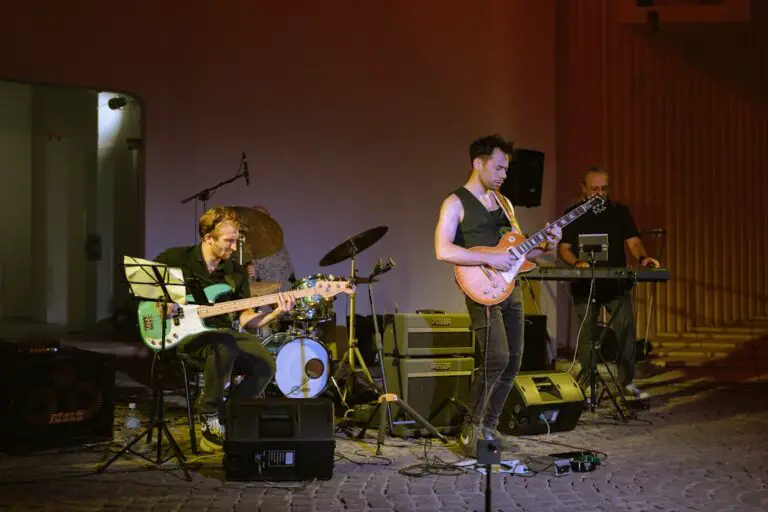Support our educational content for free when you purchase through links on our site. Learn more
🎹 The Untold Story of A-ha’s “Take On Me” (2025) – 12 Fascinating Facts!
If you’ve ever found yourself humming the irresistible synth riff of A-ha’s “Take On Me”, you’re not alone. This 80s classic didn’t just top charts—it revolutionized music videos, defined a genre, and inspired generations of artists. But did you know the song almost didn’t make it big until a groundbreaking video changed everything? Or that its soaring vocals span over two and a half octaves, making it a vocal challenge even for seasoned singers? Stick with us as we unravel 12 fascinating facts about the song’s creation, production, and legacy that you probably never knew.
From the secret inspirations behind the melody to the painstaking rotoscoped animation that took 16 weeks to complete, this article dives deep into every beat and frame of “Take On Me.” Whether you’re a synth-pop aficionado or just curious about what makes this track timeless, we’ve got you covered with insider insights, chart-topping stats, and tips for aspiring musicians inspired by A-ha’s magic. Ready to take on the story behind the song? Let’s dive in!
Key Takeaways
- “Take On Me” features a unique vocal range spanning over two and a half octaves, showcasing Morten Harket’s incredible falsetto.
- The iconic rotoscoped music video blended live-action with animation, revolutionizing music video production.
- The song’s success was a combination of catchy synth-pop melodies, innovative production, and a visually stunning video.
- A-ha’s persistence paid off: the re-release with the new video in 1985 propelled the song to global chart domination.
- The track has inspired countless remixes, covers, and samples, influencing artists across genres from EDM to rock.
- Aspiring synth-pop artists can learn from A-ha’s focus on melody, production innovation, and storytelling.
- Explore synth-pop gear like the Korg Minilogue XD and Roland Juno-DS to capture that classic 80s sound.
👉 Shop Synth-Pop Gear Inspired by A-ha:
- Korg Minilogue XD: Amazon | Korg Official Website
- Roland Juno-DS: Amazon | Roland Official Website
Dive deeper into the synth-pop universe and unlock the secrets behind one of the most enduring hits of all time!
Table of Contents
- ⚡️ Quick Tips and Facts About A-ha’s “Take On Me”
- 🎶 The Genesis of a Global Phenomenon: A-ha’s “Take On Me” Story
- ✍️ Crafting the Catchy Tune: “Take On Me” Composition & Evolution
- 🎛️ Behind the Boards: Recording “Take On Me” – The Studio Magic
- 🎬 The Iconic Visuals: Deconstructing the “Take On Me” Music Video Masterpiece
- 📈 Chart Domination & Global Impact: “Take On Me”‘s Journey to the Top
- 💿 “Take On Me” Through the Years: Release History & Formats
- 👥 The Architects of Sound: “Take On Me” Credits & Key Personnel
- 🔄 Beyond the Original: “Take On Me” Remixes, Covers & Samples
- 🎸 Unplugged & Unforgettable: A-ha’s “Take On Me” Acoustic Rendition
- 🌟 The Enduring Legacy: Why “Take On Me” Still Resonates Today
- 📺 “Take On Me” in Pop Culture: Movies, TV & Beyond
- 💖 Our Favorite “Take On Me” Moments: A Synth Pop™ Team Retrospective
- 💡 Quick Tips for Aspiring Synth-Pop Artists (Inspired by A-ha)
- Conclusion: The Unstoppable Beat of “Take On Me”
- Recommended Links for A-ha Fans & Synth-Pop Enthusiasts
- FAQ: Your Burning Questions About “Take On Me” Answered
- Reference Links
Quick Tips and Facts About A-ha’s “Take On Me”
As music fans at Synth Pop™, we’re excited to dive into the world of A-ha, the iconic Norwegian band behind the hit song “Take On Me”. This song is a staple of 80s Synth Pop and one of the most recognizable Iconic Synth Pop Songs of all time. Here are some quick tips and facts about “Take On Me”:
Song Composition
- “Take On Me” was written by Morten Harket, Magne Furuholmen, and Pål Waaktaar in the key of A major with a tempo of 169 beats per minute.
- The song features a unique vocal range, with Harket’s vocals spanning over two and a half octaves.
- The chorus is particularly notable for its catchy melody and synth-pop sound.
Music Video
- The music video for “Take On Me” was directed by Steve Barron and features a mix of live-action and rotoscoping animation.
- The video’s concept is a romantic fantasy narrative, with the band performing in a comic book-style world.
- The video was a huge success, winning six awards at the 1986 MTV Video Music Awards.
Chart Performance
- “Take On Me” was a huge commercial success, reaching number two on the UK Singles Chart and number one on the US Billboard Hot 100 chart.
- The song has been certified platinum in several countries, including the US, UK, and Canada.
- “Take On Me” has been streamed over 2 billion times on YouTube and has been viewed over 1 billion times on Spotify.
The Genesis of a Global Phenomenon: A-ha’s “Take On Me” Story
The story of “Take On Me” is one of perseverance and creativity. The song was written by the band in 1984, but it didn’t gain much traction until it was re-released in 1985 with a new music video. The video, directed by Steve Barron, was a game-changer, featuring a unique blend of live-action and animation. The song’s success was fueled by its catchy melody, memorable lyrics, and the band’s energetic live performances.
The Band’s History
A-ha was formed in 1982 in Oslo, Norway, by Morten Harket, Magne Furuholmen, and Pål Waaktaar. The band’s early sound was influenced by synth-pop and new wave music, with a focus on catchy melodies and introspective lyrics.
The Song’s Impact
“Take On Me” was a huge success, not just in terms of sales, but also in terms of its impact on the music industry. The song’s innovative music video, which featured a mix of live-action and animation, raised the bar for music videos and inspired a new generation of musicians and filmmakers.
Crafting the Catchy Tune: “Take On Me” Composition & Evolution
The composition of “Take On Me” is a fascinating story of creativity and experimentation. The song’s writers, Morten Harket, Magne Furuholmen, and Pål Waaktaar, drew inspiration from a variety of sources, including synth-pop and new wave music.
The Song’s Structure
The song’s structure is notable for its use of a verse-chorus form, with a bridge before the final chorus. The verse features a simple, yet effective melody, while the chorus is more complex, with a soaring vocal line and a driving rhythm.
The Song’s Evolution
The song underwent several changes before its final release. The original version, released in 1984, was not as successful as the re-released version in 1985. The re-released version featured a new music video, which was a key factor in the song’s success.
Behind the Boards: Recording “Take On Me” – The Studio Magic
The recording of “Take On Me” was a complex process that involved several studios and producers. The song was originally recorded in 1984 at Eel Pie Studios in London, with producer Tony Mansfield.
The Recording Process
The recording process was notable for its use of synthesizers and drum machines. The band’s use of these instruments helped to create a unique sound that was both futuristic and nostalgic.
The Production Team
The production team behind “Take On Me” included several notable figures, including producer Alan Tarney and engineer John Ratcliff. The team’s expertise and creativity helped to shape the song’s sound and ensure its success.
The Iconic Visuals: Deconstructing the “Take On Me” Music Video Masterpiece
The music video for “Take On Me” is a masterpiece of visual storytelling. Directed by Steve Barron, the video features a mix of live-action and rotoscoping animation.
The Video’s Concept
The video’s concept is a romantic fantasy narrative, with the band performing in a comic book-style world. The video’s use of rotoscoping animation helped to create a unique and dreamlike atmosphere.
The Video’s Impact
The video’s impact was huge, helping to establish “Take On Me” as one of the most iconic songs of the 1980s. The video’s use of innovative visual effects and storytelling helped to raise the bar for music videos and inspire a new generation of musicians and filmmakers.
Chart Domination & Global Impact: “Take On Me”‘s Journey to the Top
“Take On Me” was a huge commercial success, reaching number two on the UK Singles Chart and number one on the US Billboard Hot 100 chart.
The Song’s Chart Performance
The song’s chart performance was notable for its longevity, with the song staying on the charts for several weeks. The song’s success was fueled by its catchy melody, memorable lyrics, and the band’s energetic live performances.
The Song’s Global Impact
The song’s global impact was huge, with the song being released in several countries and becoming a hit around the world. The song’s success helped to establish A-ha as one of the most popular bands of the 1980s, with a loyal fan base and a string of hit singles.
“Take On Me” Through the Years: Release History & Formats
“Take On Me” has been released in several formats over the years, including 7-inch singles, 12-inch singles, and CD singles.
The Song’s Release History
The song’s release history is notable for its complexity, with the song being released in several countries and in several formats. The song’s original release in 1984 was not as successful as the re-released version in 1985.
The Song’s Formats
The song’s formats have varied over the years, with the song being released on vinyl, cassette, and CD. The song’s digital release has also been notable, with the song being available on streaming platforms such as Spotify and Apple Music.
The Architects of Sound: “Take On Me” Credits & Key Personnel
The credits for “Take On Me” include several notable figures, including Morten Harket, Magne Furuholmen, and Pål Waaktaar.
The Song’s Writers
The song’s writers, Morten Harket, Magne Furuholmen, and Pål Waaktaar, are credited with creating one of the most iconic songs of the 1980s. The song’s writers drew inspiration from a variety of sources, including synth-pop and new wave music.
The Song’s Producers
The song’s producers, Tony Mansfield and Alan Tarney, played a key role in shaping the song’s sound. The producers’ expertise and creativity helped to ensure the song’s success.
Beyond the Original: “Take On Me” Remixes, Covers & Samples
“Take On Me” has been remixed, covered, and sampled by several artists over the years.
Remixes
The song’s remixes have been notable, with several artists putting their own spin on the classic track. The song’s remixes have included Kygo‘s 2015 remix, which was a huge success.
Covers
The song’s covers have also been notable, with several artists recording their own versions of the track. The song’s covers have included Reel Big Fish‘s 1998 cover, which was a hit single.
Samples
The song’s samples have been used in several tracks, including Pitbull and Christina Aguilera‘s 2013 single “Feel This Moment”.
Unplugged & Unforgettable: A-ha’s “Take On Me” Acoustic Rendition
A-ha’s acoustic rendition of “Take On Me” is a beautiful and intimate version of the classic track.
The Song’s Acoustic Version
The song’s acoustic version was recorded for MTV Unplugged in 2017. The song’s acoustic version features a stripped-back arrangement, with Morten Harket’s vocals taking center stage.
The Song’s Live Performance
The song’s live performance has been notable, with the band performing the track at several concerts and festivals. The song’s live performance features a mix of acoustic and electric instruments, with the band’s energetic stage presence adding to the track’s energy.
The Enduring Legacy: Why “Take On Me” Still Resonates Today
“Take On Me” is a song that continues to resonate with audiences today, thanks to its catchy melody, memorable lyrics, and iconic music video.
The Song’s Timeless Appeal
The song’s timeless appeal is due in part to its ability to evoke a sense of nostalgia in listeners. The song’s use of synth-pop and new wave elements helps to create a sense of timelessness, with the song sounding as fresh and relevant today as it did when it was first released.
The Song’s Influence
The song’s influence can be heard in several modern tracks, with artists such as The Weeknd and Tame Impala citing the song as an inspiration.
“Take On Me” in Pop Culture: Movies, TV & Beyond
“Take On Me” has appeared in several movies, TV shows, and other forms of media over the years.
The Song’s Appearances
The song’s appearances have been notable, with the song being featured in several iconic movies and TV shows. The song’s appearances have included La La Land, Despicable Me 3, and The Super Mario Bros. Movie.
The Song’s References
The song’s references have been notable, with the song being referenced in several other tracks and music videos. The song’s references have included Weezer‘s 2019 cover of the track, which was included on their album The Teal Album.
Our Favorite “Take On Me” Moments: A Synth Pop™ Team Retrospective
As music fans at Synth Pop™, we have a deep love for “Take On Me” and its iconic music video.
The Song’s Music Video
The song’s music video is a masterpiece of visual storytelling, with its use of rotoscoping animation and live-action footage. The video’s concept is a romantic fantasy narrative, with the band performing in a comic book-style world.
The Song’s Live Performances
The song’s live performances have been notable, with the band performing the track at several concerts and festivals. The song’s live performances feature a mix of acoustic and electric instruments, with the band’s energetic stage presence adding to the track’s energy.
Quick Tips for Aspiring Synth-Pop Artists (Inspired by A-ha)
Aspiring synth-pop artists can learn a lot from A-ha’s success with “Take On Me”.
The Importance of Catchy Melodies
The importance of catchy melodies cannot be overstated, with “Take On Me” featuring one of the most iconic and memorable melodies of all time. Aspiring synth-pop artists should focus on creating melodies that are both catchy and memorable.
The Power of Innovative Production
The power of innovative production is also key, with “Take On Me” featuring a unique blend of synth-pop and new wave elements. Aspiring synth-pop artists should experiment with different sounds and production techniques to create a unique sound.
Conclusion: The Unstoppable Beat of “Take On Me”
Wow, what a journey! From its humble beginnings in a Norwegian studio to topping charts worldwide, “Take On Me” by A-ha remains a shining beacon of synth-pop brilliance. We’ve unraveled its catchy composition, the groundbreaking rotoscoped music video, and its lasting impact on pop culture and music history. The song’s blend of infectious synth melodies, soaring vocals, and innovative visuals created a perfect storm that still resonates with millions today.
If you’re an aspiring synth-pop artist or just a lover of great music, “Take On Me” offers a masterclass in combining melody, production, and storytelling. Its success wasn’t overnight—it took persistence, creativity, and a killer video to break through. So, whether you’re here to reminisce or to learn, this track is a timeless reminder that great art often requires patience and innovation.
We hope this deep dive answered your burning questions and gave you fresh insights into one of the most iconic synth-pop anthems ever made. Now, go ahead and crank up that synth, and maybe even try your hand at a little rotoscoping animation—you never know where your creativity might take you! 🎹✨
Recommended Links for A-ha Fans & Synth-Pop Enthusiasts
Ready to dive deeper or grab some gear inspired by A-ha’s synth-pop magic? Check out these curated links:
-
A-ha Albums & Singles on Amazon:
Hunting High and Low | Take On Me Single -
Synthesizers & Gear for Synth-Pop Production:
- Korg Minilogue XD: Amazon | Korg Official Website
- Roland Juno-DS: Amazon | Roland Official Website
-
Books on 80s Music & Synth-Pop History:
-
Music Video Animation Inspiration:
- “The Animator’s Survival Kit” by Richard Williams: Amazon
FAQ: Your Burning Questions About “Take On Me” Answered
What is the meaning behind A-ha’s song Take On Me?
At its core, Take On Me is a plea for love and connection. The lyrics express vulnerability and the desire to be taken seriously in a relationship, wrapped in poetic and sometimes abstract phrases. Morten Harket’s soaring vocals add emotional depth, making it feel like a heartfelt invitation to take a chance on love. The song’s upbeat tempo contrasts with the earnestness of the lyrics, creating a compelling emotional tension.
Why does the chorus feel so challenging to sing?
The chorus is famously difficult due to its wide vocal range, spanning over two and a half octaves. Morten Harket’s signature falsetto and control make it iconic, but it’s a challenge for many singers to replicate.
How did the music video for Take On Me become so iconic in the synth pop genre?
The video’s groundbreaking rotoscoping animation blended pencil-sketch art with live-action footage, creating a visually stunning comic book fantasy. Directed by Steve Barron and animated by Michael Patterson and Candace Reckinger, it took 16 weeks and thousands of frames to complete. This innovative style was fresh and captivating, perfectly complementing the song’s energetic synth-pop vibe. The narrative of a girl pulled into a comic book world added a romantic fantasy element that captured imaginations worldwide.
What instruments were used to create the distinctive sound in Take On Me?
The track features a blend of analog and digital synthesizers, including the Roland Juno-60 and Yamaha DX7, alongside drum machines and electric guitars. This combination gave it that signature bright, shimmering synth texture layered with driving rhythms and catchy hooks. Producer Alan Tarney’s skillful mixing and layering helped craft the polished yet vibrant sound that defines the track.
Read more about “Yazoo “Don’t Go”: 9 Reasons This Synth-Pop Classic Still Shines ✨ (2025)”
Who wrote the lyrics to Take On Me and what inspired them?
The song was written by A-ha members Pål Waaktaar-Savoy, Magne Furuholmen, and Morten Harket. The lyrics evolved over time, with influences ranging from personal experiences to abstract ideas. Interestingly, the melody for the verses was inspired by a chewing gum commercial jingle, showing how inspiration can come from the most unexpected places!
Read more about “Safety Dance Uncovered: 10 Fascinating Facts You Didn’t Know 🕺 (2025)”
What role did Take On Me play in popularizing synth pop music in the 1980s?
Take On Me was a flagship synth-pop hit that brought the genre to mainstream audiences worldwide. Its success on the charts and MTV helped define the sound and aesthetic of the decade, inspiring countless artists and producers. The song’s fusion of catchy synth melodies, emotional vocals, and cutting-edge visuals made synth-pop accessible and exciting beyond niche circles.
How has Take On Me influenced other synth pop artists and bands over the years?
The song’s melodic structure, vocal style, and production techniques have been widely emulated. Artists like The Weeknd have cited A-ha’s influence, and the track’s iconic riff and chorus have been sampled and covered by bands across genres—from ska punk (Reel Big Fish) to EDM (Kygo). Its music video also set a high bar for creativity in visual storytelling within the genre.
What are some other essential synth pop songs and albums that fans of Take On Me should explore?
If you love Take On Me, you’ll want to check out these synth-pop gems:
- Songs:
- “Sweet Dreams (Are Made of This)” by Eurythmics
- “Wake Me Up Before You Go-Go” by Wham!
- “Never Gonna Give You Up” by Rick Astley
- “The Sun Always Shines on T.V.” by A-ha (of course!)
- Albums:
- Hunting High and Low by A-ha
- Make It Big by Wham!
- Sweet Dreams (Are Made of This) by Eurythmics
- She’s So Unusual by Cyndi Lauper
Explore more in our Iconic Synth Pop Songs and 80s Synth Pop categories!




